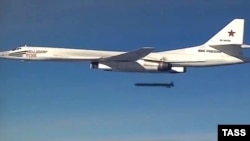Russia says it has flown two nuclear-capable bombers to its Far East region across from Alaskan territory, an action state media claim demonstrates the Kremlin's ability to base such warplanes near U.S. radar and missile-launch sites.
The Russian Defense Ministry said on August 14 that the Tupolev TU-160 Soviet-era bombers traveled more than 6,000 kilometers in eight hours from their base near Saratov to Anadyr in the Chuktoka region opposite the U.S. state.
The supersonic aircraft is capable of carrying up to 12 short-range nuclear missiles and of flying 12,000 kilometers without refueling.

The Defense Ministry said the mission was part of a tactical exercise that would last until the end of the week. It said the purpose was to practice the ability to transfer assets from their home bases to operational airfields.
Rosiiskaya gazeta, the official Russian government newspaper, said the flight displayed Moscow's ability to base nuclear bombers within 20 minutes flying time to United States.
"The arrival of [the planes] in Chukotka demonstrates Russia's ability to deploy nuclear weapons in the immediate vicinity of the United States. From Anadyr to Alaska, less than 600 kilometers -- for a Tu-160, it's 20 minutes," the newspaper said.
"Moreover, the capabilities of the missiles carried by the aircraft allow them to be launched without leaving Russian airspace," it added. "If necessary, the primary goal of missile carriers may be radars and launch sites of U.S. missile-defense interceptors deployed in Alaska."
The move comes in a time of heightened tensions between Washington and Moscow and amid a series of nonviolent air incidents involving U.S. or NATO warplanes and Russian aircraft.
On August 13, Russia's Defense Ministry claimed two of its Su-27 warplanes forced away a NATO F-18 jet after it approached an aircraft carrying Defense Minister Sergei Shoigu over international waters.
NATO on August 14 said the alliance warplanes approached the two Russian Su-27 escort jets to make visual identification because they had been traveling over the Baltic Sea without a flight plan and with their transponders shut off.
On August 9, the U.S.-Canadian North American Aerospace Defense Command (NORAD) said its fighters had intercepted two nuclear-capable Russian Tu-95 long-range bombers off the coast of Alaska.
The action took place after the Russian planes entered the Alaskan and Canadian Air Defense Identification Zones, which extend some 300 kilometers off Alaska's western coast. The planes remained in international airspace and never entered over U.S. or Canadian territory, NORAD said.













